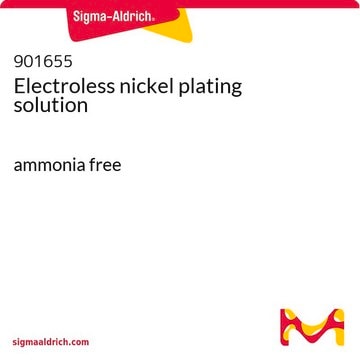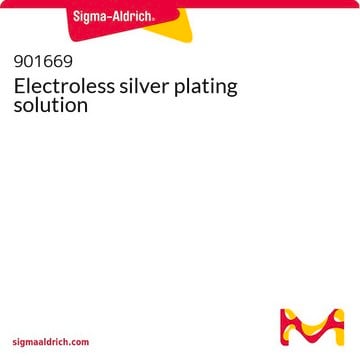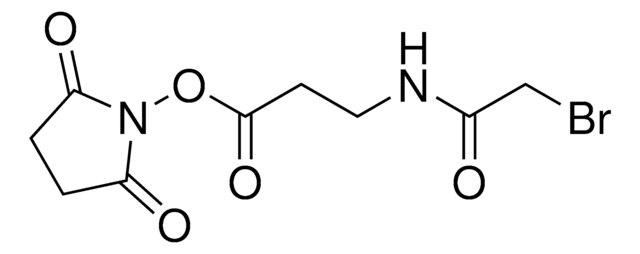Products may be shipped at a different temperature than the recommended long-term storage temperature. If the product quality is sensitive to short-term exposure to conditions other than the recommended long-term storage, it will be shipped on wet or dry-ice. If the product quality is NOT affected by short-term exposure to conditions other than the recommended long-term storage, it will be shipped at ambient temperature. As shipping routes are configured for minimum transit times, shipping at ambient temperature helps control shipping costs for our customers. For more information, please refer to the Storage and Transport Conditions document: https://www.sigmaaldrich.com/deepweb/assets/sigmaaldrich/marketing/global/documents/316/622/storage-transport-conditions-mk.pdf
901670
Bright electroless gold plating solution
Synonym(s):
Gold plating solution
Select a Size
Select a Size
About This Item
Recommended Products
form
liquid
color
colorless
pH
7-9
Related Categories
General description
Application
- Metal parts to be plated should be thoroughly cleaned before use. The normal cleaning procedures for electroplating are adequate.
- Bright electroless gold plating solution will show a decrease in pH with use. The pH should not be allowed to deviate from the normal conditions for plating since inferior deposits result. Adjustment of pH can be conveniently accomplished by the addition of small amounts of ammonium hydroxide to raise pH or citric acid to lower it.
- The recommended plating temperature is 90 °C maximum for most metals. However, for tin-lead solders and pure tin, an optimum temperature of 50 °C is recommended.
Features and Benefits
- Economical gold plating
- Plates bright gold on copper, kovar, brass, nickel, tin-lead solders and indium antimonide
- Excellent solution stability
- Operates with simple control of plating solution
- Ready-to-use - no mixing required
Signal Word
Danger
Hazard Statements
Precautionary Statements
Hazard Classifications
Acute Tox. 3 Dermal - Acute Tox. 4 Inhalation - Acute Tox. 4 Oral - Aquatic Acute 1 - Aquatic Chronic 2 - Eye Dam. 1 - Skin Corr. 1B - STOT SE 3
Target Organs
Respiratory system
Storage Class Code
6.1B - Non-combustible acute toxic Cat. 1 and 2 / very toxic hazardous materials
WGK
WGK 2
Flash Point(F)
Not applicable
Flash Point(C)
Not applicable
Choose from one of the most recent versions:
Already Own This Product?
Find documentation for the products that you have recently purchased in the Document Library.
Customers Also Viewed
-
How is shipping temperature determined? And how is it related to the product storage temperature?
1 answer-
Helpful?
-
-
How can I determine the shelf life / expiration / retest date of this product?
1 answer-
If this product has an expiration or retest date, it will be shown on the Certificate of Analysis (COA, CofA). If there is no retest or expiration date listed on the product's COA, we do not have suitable stability data to determine a shelf life. For these products, the only date on the COA will be the release date; a retest, expiration, or use-by-date will not be displayed.
For all products, we recommend handling per defined conditions as printed in our product literature and website product descriptions. We recommend that products should be routinely inspected by customers to ensure they perform as expected.
For products without retest or expiration dates, our standard warranty of 1 year from the date of shipment is applicable.
For more information, please refer to the Product Dating Information document: https://www.sigmaaldrich.com/deepweb/assets/sigmaaldrich/marketing/global/documents/449/386/product-dating-information-mk.pdfHelpful?
-
-
When plating directly onto copper for an electrical contact application, will this provide corrosion-resistant surface for storage for a few months prior to next steps? How important is a Nickel diffusion barrier?
1 answer-
The gold coating should provide a corrosion-resistant surface for storage, with thicker coatings offering greater resistance. It is advisable to store the plated copper in a sealed container with inert gas to enhance protection. A nickel diffusion barrier can be beneficial, but its importance depends on the specific storage conditions.
Helpful?
-
-
What are the main solvents used in this solution? I am uncertain as to what to write on the hazardous waste disposal tag in terms of percentages. Thanks!
1 answer-
Unfortunately, the chemical composition of this product is considered proprietary. However, any hazardous ingredients are listed in the product Safety Data Sheet (SDS), section 3.
Please refer to this document to review available information.Helpful?
-
-
What is the recommended plating process (procedure, temperature, etc.) for this product (901670)?
1 answer-
This product is not specifically tested for plating and a specific procedure is not available. However, metal parts to be plated should be thoroughly cleaned before use. The normal cleaning procedures for electroplating are adequate. This solution will show a decrease in pH with use. The pH should not be allowed to deviate from the normal conditions for plating, as inferior deposits result. Adjustment of pH can be conveniently accomplished by the addition of small amounts of ammonium hydroxide to raise pH or citric acid to lower it. The table below offers additional recommended conditions.
Helpful?
-
-
Is it possible to use product 901670 to plate on a surface that is already coated with gold?
1 answer-
Product 901670 is not suitable for deposition onto gold. It operates via a displacement mechanism and will not displace itself to build thickness on a gold surface.
Helpful?
-
-
Could bright electroless gold (901670) be deposited onto silver formed by electroless silver solution (901669)?
1 answer-
901670 confirmed it will not deposit onto silver.
Helpful?
-
-
Is electroless gold plating solution suitable on SS 316L components. Also will the plated gold color remains same if the component is heated at 500 deg C.
1 answer-
To get this to react, the stainless steel would first need to be coated with a metal that the solution can displace, (e.g. copper, commercial brass, Kovar, nickel, tin-lead solders, pure tin, iron, and indium antimonide). The solution cannot plate stainless steel. The most recommended approach would probably be to attempt to plate using the Electroless nickel plating solution, followed by a Bright Electroless gold plating solution. This would not be guaranteed to work, but it would be the most logical route.
Helpful?
-
-
What are optimal temperatures for depositing gold and silver, using the corresponding electroless plating solutions, onto copper? We found that higher temperatures resulted in rapid evaporation in the fume hood.
1 answer-
The recommended plating temperature of both gold and silver electroless plating solution is 90 °C for most metals. Higher temperature leads to faster evaporation.
Helpful?
-
-
Where can I find the protocol for electroless gold plating on platinum electrodes?
1 answer-
A specific protocol is not readily available for this product. Please see the link below to a pubication that may be helpful:
https://core.ac.uk/download/pdf/81857506.pdfHelpful?
-
Active Filters
Our team of scientists has experience in all areas of research including Life Science, Material Science, Chemical Synthesis, Chromatography, Analytical and many others.
Contact Technical Service












